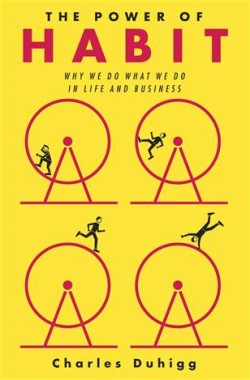What We're Reading Now
Why Bad Habits Happen to Good People
10 April 2018
Eden read The Power of Habit: Why We Do What We Do in Life and Business by Charles Duhigg and thought about how understanding the habit loop could help her break some bad habits.
Tags: balance, eden read, productivity, time management and prioritization
When I think about habits, I tend to think about the mindless actions I catch myself doing. Some examples are chewing my nails, reaching for my smartphone, or logging into social media. It is sad but true that I have caught myself closing a window on my computer only to open a new tab almost immediately and return to the same social media website that I had just closed...all out of habit.
I learned while reading The Power of Habit: Why We Do What We Do in Life and Business, by Charles Duhigg, that habits don’t just refer to the undesirable tendencies we observe in ourselves. Habits can also be beneficial or time-saving routines, like brushing your teeth or putting your keys in the same place every day. What all habits, good or bad, have in common is that they follow what Duhigg calls the “habit loop” of cue, routine, and reward. Duhigg believes that dissecting our habits into these three steps can help us identify and change powerful patterns of behavior that we would otherwise perceive as automatic.

I tried applying the habit loop to my tendency to reach for my smartphone in social situations and came up with the following steps:
- Trigger: I am in a new social situation
- Routine: I reach for my smartphone and check texts, email, and social media
- Reward: I avoid feeling awkward
Once you’ve recognized how your actions fit into the habit loop, Duhigg says that the most successful way to change behavior is to follow what he calls the “The Golden Rule of Habit Change.” The Golden Rule of Habit Change is to create a new habit loop with the same cue, the same reward, but a different routine. After you recognize the cues that lead to your routine, you can practice replacing your old routine with a new one that results in the same reward.
One new routine that I imagined for myself is to replace looking at my smartphone with introducing myself to someone near me and asking her to tell me about herself. This way, I don’t have to worry about leading the conversation. I know that I enjoy most conversations after they begin, so I am going to practice introducing myself more often and see if this change in routine results in the same reward of avoiding feeling awkward.
Do you have any habits that fit into the habit loop? What are your ideas for replacing your routines to create new behaviors? I’d love to hear your thoughts in the comments.







Comments
Our Comment Policy:
Our blog posts are only half of the conversation. What our readers have to say is equally important to us, and we're grateful for all the comments that continue the dialog.
To ensure that the discussion here is as useful as possible to all of our readers, please be respectful of our contributors and refrain from harassing, threatening and/or vulgar language. We reserve the right to screen and remove any comments from the site. If you have a question about a comment or want to discuss our policy, please contact us. We'll talk it over.
There are no comments for this entry yet.